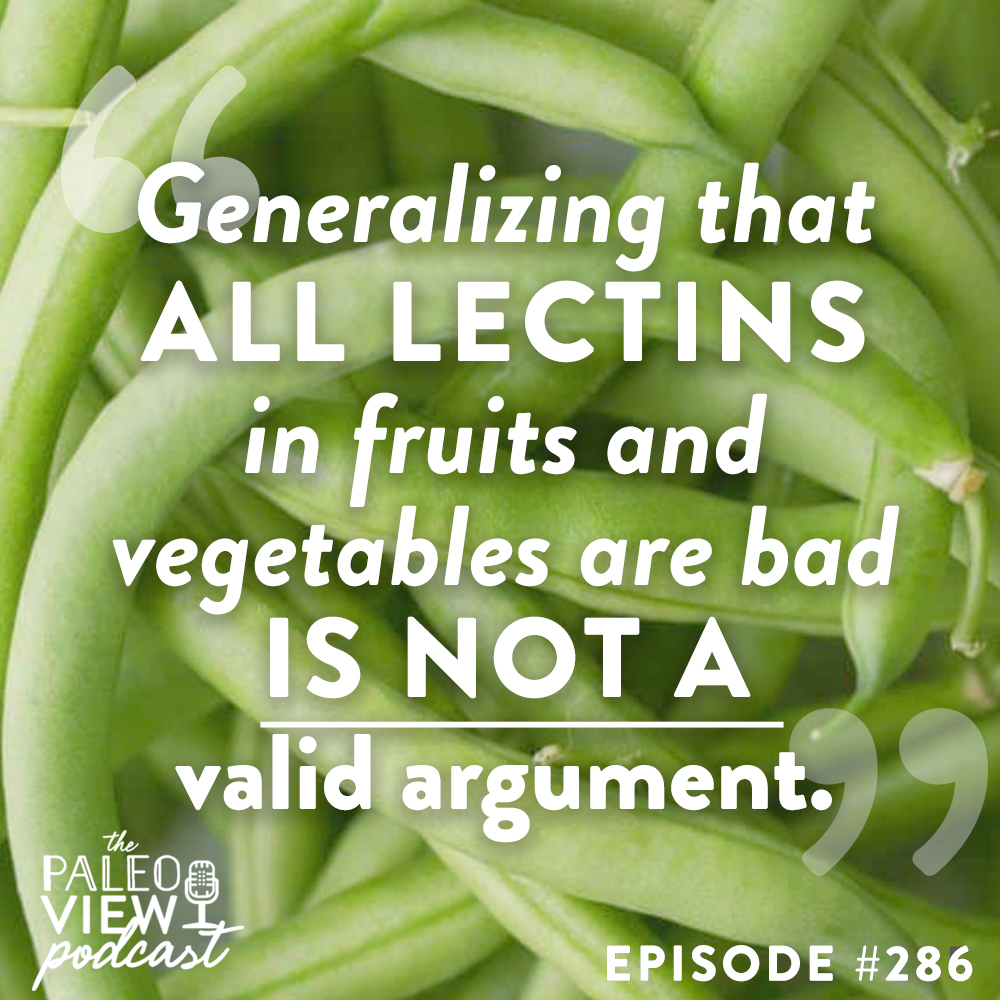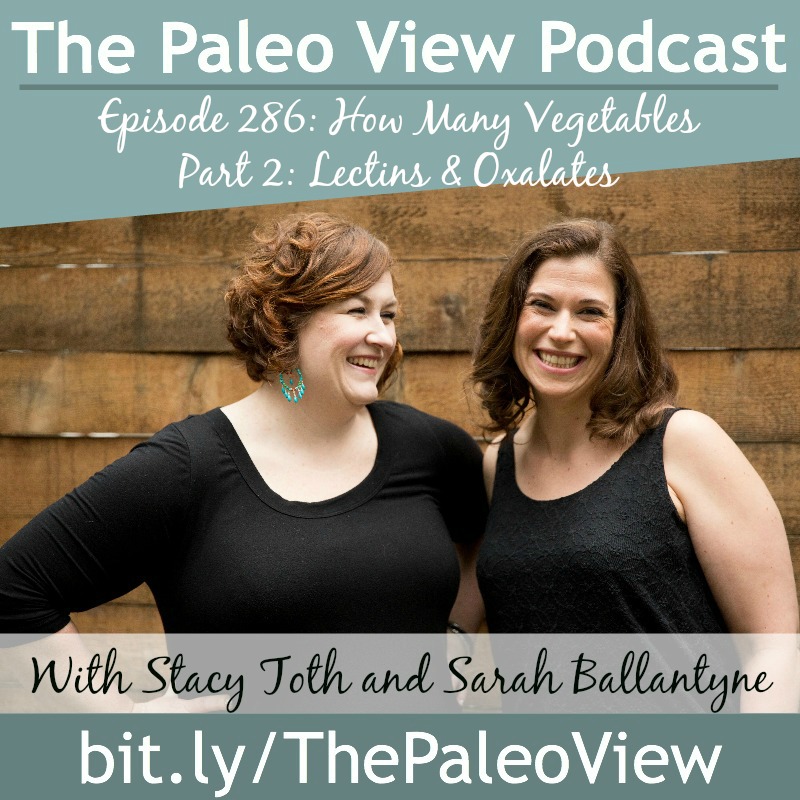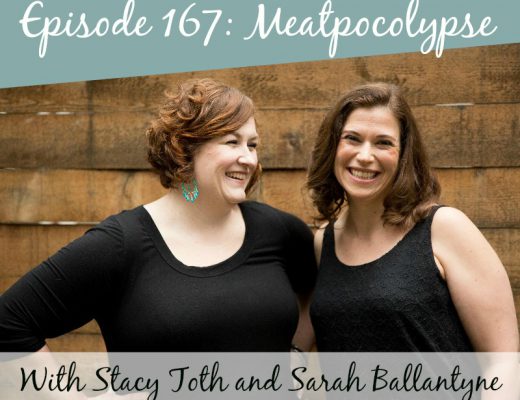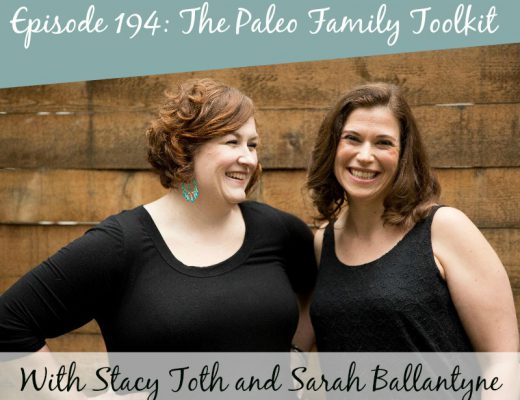Ep. 286: How Many Vegetables Part 2: Lectins & Oxalates
In this episode, we’re talking vegetables again! Specifically, we’re talking about lectins and oxalates!
Click here to listen in iTunes
or download and listen by clicking the PodBean Player below
![]()
If you enjoy the show, please review it in iTunes!
The Paleo View (TPV), Episode 286: How Many Vegetables Part 2: Lectins & Oxalates
- Intro (0:00)
- News and Views (0:40)
- Thank you to our listeners who have made it through all 286 episodes of our podcast, bad jokes, puns and all!
- Sarah shares her current favorite pun.
- Matt and Stacy’s son Cole would be rolling his eyes.
- The gap between what parents and kids think Youtube is for and how they use it.
- Sarah’s been breaking out “when I was a kid” a lot lately to her daughters.
- We got amazing positive response from the vegetable podcast last month.
- We love that our listeners love learning and gaining information!
- Thanks for tagging us in your photos and letting us know we’re helping you to eat more veggies!
- If you haven’t listened to the first veggie podcast yet, it lays the groundwork for today’s episode.
- Thank you to our listeners who have made it through all 286 episodes of our podcast, bad jokes, puns and all!
- Listener Questions (12:50)
- LECTINS: Bits and pieces from questions by listeners Sarah and Rita regarding the The Plant Paradox diet, which an very anti-lectin diet and involves eliminating grains, legumes, nightshades, as well as large number of vegetables and fruits with a higher lectin content, such as most things with skin and seeds.
- Listener Sarah would love to hear Sarah’s take on lectins and any other information on the recommendations in this book.
- Lectins are a broad class of carbohydrate-binding proteins.
- There are many different ones, and they are highly specific for specific types of sugar.
- Many are found in our bodies and some have vital roles in our health.
- There are lectins in every form of life.
- The original branding of the Paleo diet as anti-lectin is somewhat misleading.
- Paleo aims to eliminate prolamines and agglutinins, which are most problematic for our intestines and hard for our bodies to break down.
- A recent studied showed that even in healthy people, gliadin fragments were shown to trick the gut cells into bringing them into the body, where then bind with receptors in the liver and fat cells and turn on signals to gain weight.
- This could help explain the connection between gluten consumption and obesity.
- It is important for us to be more specific in describing the two classes of lectins we aim to avoid.
- A frame work that generalizes all lectins and advocates omitting all of them from the diet is misunderstanding the science.
- Nightshades have agglutinins, which are toxic lectins, and problematic.
- Nightshades are a different botanical group with most being toxic to humans.
- Anti-nutrients do tend to be concentrated in the peels of fruits and vegetables.
- The peels are often also where higher antioxidant content is as well.
- The only fruits and vegetables to arguably eliminate because of toxic lectin content are those in the Nightshade family (which are technically fruit).
- Common Nightshades are: tomato, potato, peppers, eggplant, tomatill0s, goji berries.
- Sarah has a comprehensive list of nightshades on her website.
- Stacy doesn’t eat most nightshades, here is an archive of nightshade-free recipes.
- Common Nightshades are: tomato, potato, peppers, eggplant, tomatill0s, goji berries.
- The big picture is that every food may have positives and negatives, for example: dairy and coffee.
- It is easy to to take part of the information and focus on just the bad.
- We try to take a more holistic approach when we’re talking about foods and our individual needs.
- Everyone is different, so you have to test what works for you.
- Seeing zucchini on the list of veggies to avoid made Stacy laugh because it is one of the most mild vegetables and isn’t on any many other “no” lists; it is tolerated well by most people.
- Listener Sarah was curious how to explain the testimonies of all the people being helped by The Plant Paradox diet.
- This diet also eliminates a lot of other things that are problematic for a lot of people.
- Something like the Paleo Diet or Autoimmune Protocol are two options much more founded in science, that recognize bio-individuality, and endorse self-experimentation to figure out what works for each person.
- In Paleo Principles, Sarah aimed to be extremely clear about the current boundries of human knowledge regarding food.
- Many foods are not black and white, having both pros and cons.
- Sarah doesn’t subscribe to a dogmatic approach, even regarding gluten.
- There are over 1400 references in Paleo Principles, and is based on a much more sophisticated ground than simply “all lectins are bad.”
- OXALATES: Listener Rita wants to know about oxalates and the recommendation to avoid them.
- Oxalate is in a similar category as phytate because it binds to minerals and makes them less absorbable by our bodies and are considered by some to be “anti-nutrients.”
- The minerals can be liberated by our gut bacteria.
- Our bodies also produce oxalates, as a product of metabolism.
- Many high oxalate foods like kale, collards, spinach, chard, most berries and nuts, sweet potatoes, chocolate, cruciferous veggies, beets, cassava, rhubarb, etc can still be part of a healthy Paleo diet.
- To remove all these foods would be very limiting.
- There is no medical definition for oxalate sensitivity like there is for other types of sensitivities.
- The mechanism is not well-understood.
- It usually refers to people who are prone to kidney stones or muscle and joint pain when they eat high-oxalate foods.
- Some people produce a lot of oxalates, which they have a hard time eliminating, causing calcium-oxalate crystals in the kidneys, which develop into stones.
- If oxalate concentrations become too high in the blood, they can build up in the joints causing oxalate arthritis.
- 1 in 3 million people are genetically pre-disposed to these conditions.
- People with absorption disorders (like Crohn’s disease) are more prone also.
- Dietary oxalates don’t proportionately increase urinary oxalates.
- We have a variety of biologically mechanisms to control our oxalate levels.
- Certain gut bacteria work to degrade oxalates and reduce absorption.
- This why someone with a gut disorder might be more prone to problems with oxalates.
- You can increase these type of bacteria by eating more oxalates. Feed them!
- Certain gut bacteria work to degrade oxalates and reduce absorption.
- Dehydration is the number one cause of oxalate stones and crystals.
- Calcium supplementation and deficiency increase risk of stones.
- To avoid this, eat plenty of dietary Calcium.
- We have a variety of biologically mechanisms to control our oxalate levels.
- The arguments against eating oxalates are only valid for a limited specific number of people.
- It is a myth that eating oxalates or phytates will suck nutrients from your body.
- They are by definition already bound to minerals and therefore can’t bind with anything else.
- Our gut bacteria can liberate the minerals.
- The minerals in the vegetable might be harder for us to absorb because of the reliance on gut health.
- These vegetables aren’t full of things that are going to sop up all the minerals in our bodies and make us deficient in minerals.
- These foods feed beneficial bacteria and by that mechanism can actually help reduce risk of stones and encourage oxalate homeostasis.
- There is a lot of overlap between oxalate, histamine, and salicylate food lists.
- When oxalate sensitivity is based only on symptoms, it could be misunderstanding.
- The symptoms of these intolerances are all similar.
- It could be beneficial to investigate further into which sensitivity you are actually dealing with.
- There isn’t a compelling reason to eliminate high oxalate food for most people.
- Stacy used to partly cook spinach and be careful about eating it with other foods to avoid absorption issues.
- Sarah says, “it’s not a thing!”
- Eating raw spinach with other foods isn’t going to inhibit absorption of nutrients from other food.
- The presence of a compound bound with a mineral doesn’t mean other nutrients will not be absorbed.
- It means the mineral it is bound to requires being unbound before you can absorb it.
- Eat spinach. Spinach is great! Eat it however you like it.
- There are tests you can do through your doctor to determine oxalate levels or oxalate sensitivity.
- This should not be diagnosed based on symptoms alone. Test for it if you suspect it.
- Oxalate sensitivity is a very low frequency sensitivity.
- “It’s the candida of food sensitivities.”
- Very frequently diagnosed by symptoms and often not actually candida.
- Plug for functional medicine- they actually test and have knowledgeable ways of dealing with things.
- “It’s the candida of food sensitivities.”
- Oxalate is in a similar category as phytate because it binds to minerals and makes them less absorbable by our bodies and are considered by some to be “anti-nutrients.”
- If you have more vegetable related questions, reach out through the contact forms on our websites or social media.
- If you’ve enjoyed the show, please recommend it to someone who might enjoy it.
- We love when you share and when you leave reviews for us!
- Stacy will have a Self-Love post new on the blog, based on a talk she is giving soon!
- Thanks for listening, we’ll be back next week!
- LECTINS: Bits and pieces from questions by listeners Sarah and Rita regarding the The Plant Paradox diet, which an very anti-lectin diet and involves eliminating grains, legumes, nightshades, as well as large number of vegetables and fruits with a higher lectin content, such as most things with skin and seeds.
Support us by shopping through links on our sidebars- thanks!






